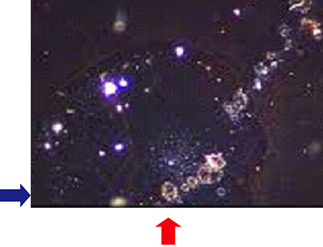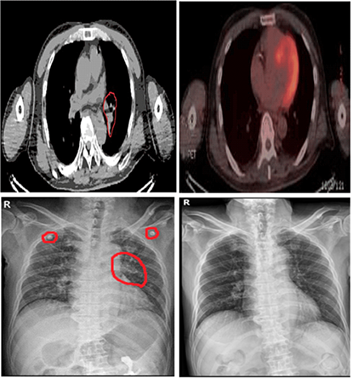Case Report
Theranostic Modality by NACL + KCL Solution on Multiple Metastatic Prostate Cancer: A Clinical Image
- Chur Chin *
Department of Emergency Medicine, Semin Hospital, Daegu, South Korea.
*Corresponding Author: Chur Chin, Department of Emergency Medicine, Semin Hospital, Daegu, South Korea.
Citation: Chur Chin. (2024). Theranostic Modality by NACL + KCL Solution on Multiple Metastatic Prostate Cancer: A Clinical Image, Clinical Case Reports and Studies, BioRes Scientia Publishers. 6(4):1-3. DOI: 10.59657/2837-2565.brs.24.165
Copyright: © 2024 Chur Chin, this is an open-access article distributed under the terms of the Creative Commons Attribution License, which permits unrestricted use, distribution, and reproduction in any medium, provided the original author and source are credited.
Received: July 10, 2024 | Accepted: July 26, 2024 | Published: August 02, 2024
Abstract
Herein, we report a case of multiple metastatic prostate cancer. A 63-year-old man presented with paraplegia under anesthesia following transurethral prostate resection. 18F-fluorocholine positron emission tomography-computed tomography and magnetic resonance imaging detected multiple axial bone and pulmonary metastases with multiple lymph node invasions. Palliative radiotherapy was administered. The patient’s pulmonary nodules disappeared after the infusion of a NaCl + KCl solution.
Keywords: NaCl + KCl; prostate cancer; multiple bone metastasis; pulmonary nodules; multiple lymph node invasion
Introduction
In this study, we attempted to establish several pairs of annihilations for cancer therapy. If cancer cells can be selectively removed using graphene, we could ultimately have a perfect theragnostic modality for cancer treatment. Unlike heavy-ion cancer therapy, pair annihilation therapy does not require radiation exposure. It is cheap, safe, without side effects, and has a short treatment schedule, even once for hyper vascular tumors.
Case Description
A 63-year-old man presented with severe bilateral lower limb weakness that had worsened over 3 days before presentation. Neurological examination under anesthesia revealed paraplegia below the T10 sensory dermatome. The only abnormality found in the erythrocyte sedimentation rate was 104 mm/h, and C-reactive protein was 3.35 mg/dL. 18F-fluorocholine positron emission tomography-computed tomography showed increased F-FCH uptake in the left pericardial and urinary bladders (stage T4N1M1) and enlargement of multiple bilateral pulmonary nodules. Electrocardiography revealed a Wenchebach-type second-degree atrioventricular (AV) block. Moreover, the mediastinal, para-aortic, aortocaval, and retrocrural lymph nodes showed increased F-FCH uptake. Magnetic resonance images obtained with and without contrast show multiple destructive lesions in the axial bones of the thoracic, lumbar, and sacral regions (T 12, L 1-3, and S 1-2). Transurethral resection of the prostate revealed prostate cancer. The patient received palliative radiotherapy.
Table 1: Graphene incubation study with 3 kinds of colloidal gold (GNP2 unknown, GNP3 at 5nm in 10ppm, and GNP4 at 5nm in 240ppm) in water.
| Solution 1 | Solution 2 | |||||
| D9 | D36 | D253 | D9 | D36 | D253 | |
| Chip (C)/Filament(F) | ||||||
| GNP1 | 1 / 0 | 1 / 0 | 2 / 2 | 2 / 0 | 2 / 0 | 2 / 2 |
| GNP2 | 1 / 0 | 0 / 1 | 1 / 0 | 0 / 2 | ||
| GNP3 | 2 / 0 | 0 / 1 | 1 / 0 | 0 / 2 | ||
Re-floating over the graphene, pair annihilation by repeated injection of NaCl + KCl solution, or oral intaking the colloid gold with camostat mesilate over 1 month.
The patient subsequently received 250 mL of normal saline with 5 cc of potassium chloride (KCl) as a graphene exfoliator (Figure 1), intravenously over 6 h. Multiple pulmonary nodules in both lung field was disappeared (Figure 2) [1,2].
Figure 1: Proposed mechanism to exert a carcinogenic effect. Red arrow: presence of lipid nanoparticle (LNP)-encapsulated plasmid DNA. Blue arrow: LNP adsorbed on graphene.
Figure 2: Instant disappearance of multiple pulmonary nodules with mediastinal lymphadenopathy by NaCl + KCl solution.
Discussion
The weak force of the standard model of particle physics induces an asymmetry between matter and antimatter. Matter can spontaneously oscillate into antimatter. Some patients with blood clots can recover from the symptoms instantly with a NaCl +KCl solution; however, in rare cases, the symptoms reappear after a time interval. This may result from the oscillation or imbalance between matter and antimatter.
A case similar to that of a 70-year-old male patient who had status epilepticus and fully recovered mentality after NaCl +KCl solution revealed no specific changes in computed tomography (CT) findings before and after the event. If the NaCl +KCl solution induces thrombolysis, evidence of partial thrombolysis or penumbra should appear within 6 h. Therefore, we can infer that the solution effect is due to pair annihilation and not thrombolysis. Additional comparison cases for various solution concentrations should be evaluated to identify the pair-annihilation phenomenon.
Conclusion
Instant removal of the tumor mass or blood clots by the NaCl +KCl solution may be related to pair annihilation. We identified this phenomenon in a patient with prostate cancer, lung metastasis, and instant recovery from right middle cerebral artery occlusion in a patient with status epilepticus. Therefore, a more detailed evaluation is needed.
Declarations
Ethical Agreement
Our institute does not require ethical approval for reporting individual cases or case series.
Conflicts of Interest
The author declares no conflicts of interest regarding the publication of this paper.
References
- Chin C. (2023). Comparison of 50 Cases of The Anti-Cancer Effects of NACL with KCL as A Potent Graphene Exfoliator, Prehydrated Patients to NACL-Only Prehydrated Patients on The Terminal Stage Cancer Patients. Case Rep Clin Med. 12:425-431.
Publisher | Google Scholor - Chin C. (2024). An Alternative Mechanism for The Instant Removal of Hyper Vascular Anaplastic Meningioma with Recovery of Mentality with NaCl + KCl. Case Rep Clin Med. 13:213-218.
Publisher | Google Scholor - Roger Penrose, Gravitational collapse and space-time singularities, Physical Review Letters. 1965: 14(3):57-59.
Publisher | Google Scholor
















